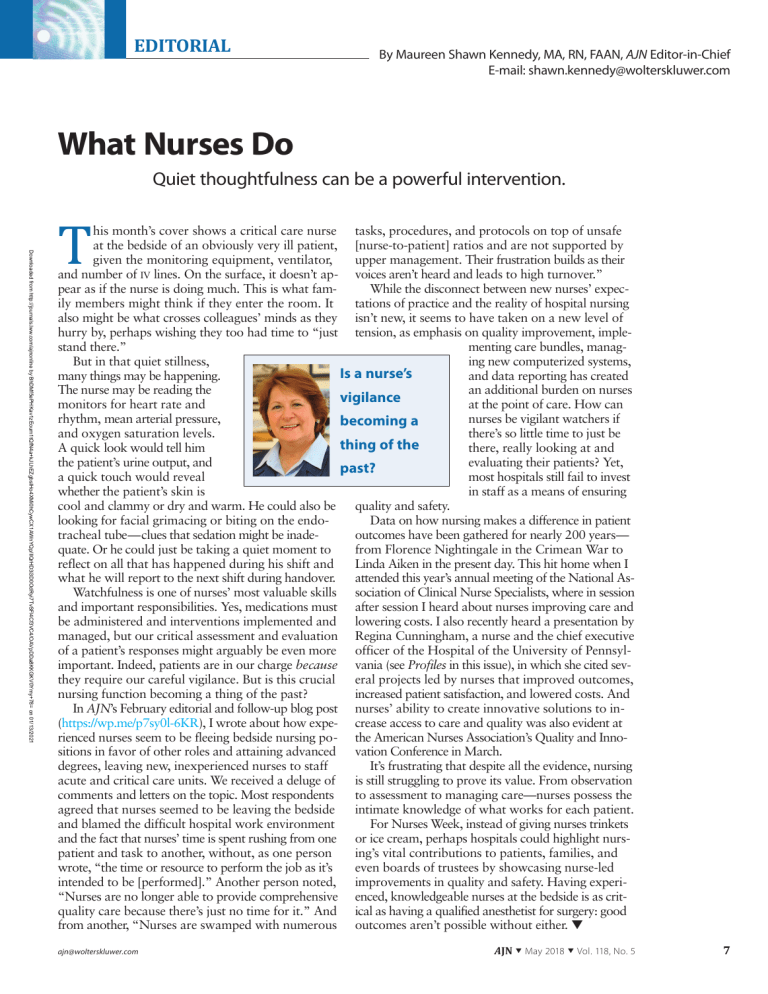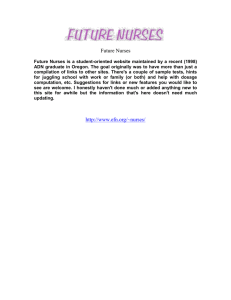
EDITORIAL By Maureen Shawn Kennedy, MA, RN, FAAN, AJN Editor-in-Chief E-mail: shawn.kennedy@wolterskluwer.com What Nurses Do Quiet thoughtfulness can be a powerful intervention. Downloaded from http://journals.lww.com/ajnonline by BhDMf5ePHKav1zEoum1tQfN4a+kJLhEZgbsIHo4XMi0hCywCX1AWnYQp/IlQrHD3i3D0OdRyi7TvSFl4Cf3VC4/OAVpDDa8KKGKV0Ymy+78= on 01/13/2021 T his month’s cover shows a critical care nurse tasks, procedures, and protocols on top of unsafe at the bedside of an obviously very ill patient, [nurse-to-patient] ratios and are not supported by given the monitoring equipment, ventilator, upper management. Their frustration builds as their and number of IV lines. On the surface, it doesn’t ap- voices aren’t heard and leads to high turnover.” pear as if the nurse is doing much. This is what famWhile the disconnect between new nurses’ expecily members might think if they enter the room. It tations of practice and the reality of hospital nursing also might be what crosses colleagues’ minds as they isn’t new, it seems to have taken on a new level of hurry by, perhaps wishing they too had time to “just tension, as emphasis on quality improvement, implestand there.” menting care bundles, managBut in that quiet stillness, ing new computerized systems, Is a nurse’s many things may be happening. and data reporting has created The nurse may be reading the an additional burden on nurses vigilance monitors for heart rate and at the point of care. How can rhythm, mean arterial pressure, nurses be vigilant watchers if becoming a and oxygen saturation levels. there’s so little time to just be thing of the A quick look would tell him there, really looking at and the patient’s urine output, and evaluating their patients? Yet, past? a quick touch would reveal most hospitals still fail to invest whether the patient’s skin is in staff as a means of ensuring cool and clammy or dry and warm. He could also be quality and safety. looking for facial grimacing or biting on the endoData on how nursing makes a difference in patient tracheal tube—clues that sedation might be inadeoutcomes have been gathered for nearly 200 years— quate. Or he could just be taking a quiet moment to from Florence Nightingale in the Crimean War to reflect on all that has happened during his shift and Linda Aiken in the present day. This hit home when I what he will report to the next shift during handover. attended this year’s annual meeting of the National AsWatchfulness is one of nurses’ most valuable skills sociation of Clinical Nurse Specialists, where in session and important responsibilities. Yes, medications must after session I heard about nurses improving care and be administered and interventions implemented and lowering costs. I also recently heard a presentation by managed, but our critical assessment and evaluation Regina Cunningham, a nurse and the chief executive of a patient’s responses might arguably be even more officer of the Hospital of the University of Pennsylimportant. Indeed, patients are in our charge because vania (see Profiles in this issue), in which she cited sevthey require our careful vigilance. But is this crucial eral projects led by nurses that improved outcomes, nursing function becoming a thing of the past? increased patient satisfaction, and lowered costs. And In AJN’s February editorial and follow-up blog post nurses’ ability to create innovative solutions to in(https://wp.me/p7sy0l-6KR), I wrote about how expe- crease access to care and quality was also evident at rienced nurses seem to be fleeing bedside nursing po- the American Nurses Association’s Quality and Innositions in favor of other roles and attaining advanced vation Conference in March. degrees, leaving new, inexperienced nurses to staff It’s frustrating that despite all the evidence, nursing acute and critical care units. We received a deluge of is still struggling to prove its value. From observation comments and letters on the topic. Most respondents to assessment to managing care—nurses possess the agreed that nurses seemed to be leaving the bedside intimate knowledge of what works for each patient. and blamed the difficult hospital work environment For Nurses Week, instead of giving nurses trinkets and the fact that nurses’ time is spent rushing from one or ice cream, perhaps hospitals could highlight nurspatient and task to another, without, as one person ing’s vital contributions to patients, families, and wrote, “the time or resource to perform the job as it’s even boards of trustees by showcasing nurse-led intended to be [performed].” Another person noted, improvements in quality and safety. Having experi“Nurses are no longer able to provide comprehensive enced, knowledgeable nurses at the bedside is as crit­ quality care because there’s just no time for it.” And ical as having a qualified anesthetist for surgery: good from another, “Nurses are swamped with numerous outcomes aren’t possible without either. ▼ ajn@wolterskluwer.com AJN ▼ May 2018 ▼ Vol. 118, No. 5 7

